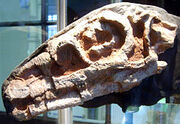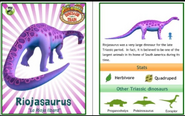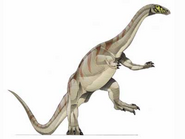No edit summary Tags: Visual edit apiedit |
(Editing a gallery) |
||
| (22 intermediate revisions by 9 users not shown) | |||
| Line 1: | Line 1: | ||
| + | [[File:240px-Riojasaurus_skull.jpg|thumb|''Riojasaurus skull'']] |
||
| − | ''' |
+ | '''''Riojasaurus'''''(meaning"Rioja lizard") was a herbivourous sauropodomorph dinosaur named after La Rioja Province in Argentina where it was found by José Bonaparte. It lived during the Late Triassic and grew to about 10 metres (33 feet) long. ''Riojasaurus'' is the only known riojasaurid to live in South America. |
| − | == |
+ | ==Description== |
| − | ''Riojasaurus'' had a heavy body, bulky legs, and a long neck and tail. Its leg bones were dense and massive for an early sauropodomorph. By contrast, its vertebrae were lightened by hollow cavities, and unlike most early sauropodomorphs, ''Riojasaurus'' had four sacral vertebrae instead of three. It has been thought it probably moved slowly on all fours and was unable to rear up on its back legs. The nearly equal length of the fore and hindlimbs has also been interpreted as suggestive of an obligatorily quadrupedal gait. However in 2016, Scott Hartman found the hand anatomy, relatively straight back and largely immobile shoulder girdle of ''Riojasaurus'' supported it being a biped. No skull was found with the first skeleton of ''Riojasaurus'', although a well-preserved skull attributed to ''Riojasaurus ''was found later. The teeth of ''Riojasaurus'' were leaf shaped and serrated. The upper jaw contained 5 teeth at the front, with 24 more behind them in a row that ended under the eyes. Comparisons between the scleral rings of ''Riojasaurus'' and modern birds and reptiles suggest that it may have been cathemeral, active throughout the day at short intervals. |
+ | ''Riojasaurus'' had a heavy body, bulky legs, and a long neck and tail. Its leg bones were dense and massive for an early sauropodomorph. By contrast, its vertebrae were lightened by hollow cavities, and unlike most early sauropodomorphs, ''Riojasaurus'' had four sacral vertebrae instead of three. It has been thought it probably moved slowly on all fours and was unable to rear up on its back legs. The nearly equal length of the fore and hindlimbs has also been interpreted as suggestive of an obligatorily quadrupedal gait. However in 2016, Scott Hartman found the hand anatomy, relatively straight back and largely immobile shoulder girdle of ''Riojasaurus'' supported it being a biped. No skull was found with the first skeleton of ''Riojasaurus'', although a well-preserved skull attributed to ''Riojasaurus ''was found later. The teeth of ''Riojasaurus'' were leaf shaped and serrated. The upper jaw contained 5 teeth at the front, with 24 more behind them in a row that ended under the eyes. Comparisons between the scleral rings of ''Riojasaurus'' and modern birds and reptiles suggest that it may have been cathemeral, active throughout the day at short intervals. |
| − | == |
+ | ==Classification== |
| − | Many scientists think that ''Riojasaurus'' was closely related to ''Melanorosaurus'', known from the Triassic-Early |
+ | Many scientists think that ''Riojasaurus'' was closely related to ''Melanorosaurus'', known from the Triassic-Early Jurassic period. However, studies at Bristol University, England, suggest that it is unique in some key ways, such as the longer bones in its neck. It is certainly quite different from other sauropodomorphs found in the Los Colorados Formation of Argentina. Due to their size and limb anatomy, ''Riojasaurus'' and the possibly related ''Melanorosaurus ''have been considered close relatives of the earliest sauropods. |
| + | ==In popular culture== |
||
| + | * Riojasaurus appeared on [[Dinosaur Train]]. |
||
| + | |||
| + | ==Gallery== |
||
| + | <gallery> |
||
| + | Screenshot 2019-08-15-16-48-33.png |
||
| + | Screenshot_2019-08-18-10-01-29.png |
||
| + | 39588.jpg |
||
| + | 39588b.jpg |
||
| + | JPI Riojasaurus.png |
||
| + | </gallery> |
||
| + | |||
| + | ==Videos== |
||
| + | <gallery> |
||
| + | File:Riojasaurus |
||
| + | </gallery> |
||
[[Category:Dinosaurs]] |
[[Category:Dinosaurs]] |
||
[[Category:Prosauropods]] |
[[Category:Prosauropods]] |
||
| Line 14: | Line 31: | ||
[[Category:Dinosaurs of South America]] |
[[Category:Dinosaurs of South America]] |
||
[[Category:Argentina Dinosaurs]] |
[[Category:Argentina Dinosaurs]] |
||
| + | [[Category:Dinopedia]] |
||
| + | [[Category:Mravid]] |
||
| + | [[Category:Taxa named by José Bonaparte]] |
||
| + | [[Category:Fossil taxa described in 1967]] |
||
| + | [[Category:How Do Dinosaurs Creatures]] |
||
| + | [[Category:The Land Before Time Creatures]] |
||
| + | [[Category:Dinosaur Train creatures]] |
||
| + | [[Category:Eyewitness Dinosaur Hunter]] |
||
| + | [[Category:Dinosaurs: Fun, Fact and Fantasy creatures]] |
||
Revision as of 02:15, 19 August 2020

Riojasaurus skull
Riojasaurus(meaning"Rioja lizard") was a herbivourous sauropodomorph dinosaur named after La Rioja Province in Argentina where it was found by José Bonaparte. It lived during the Late Triassic and grew to about 10 metres (33 feet) long. Riojasaurus is the only known riojasaurid to live in South America.
Description
Riojasaurus had a heavy body, bulky legs, and a long neck and tail. Its leg bones were dense and massive for an early sauropodomorph. By contrast, its vertebrae were lightened by hollow cavities, and unlike most early sauropodomorphs, Riojasaurus had four sacral vertebrae instead of three. It has been thought it probably moved slowly on all fours and was unable to rear up on its back legs. The nearly equal length of the fore and hindlimbs has also been interpreted as suggestive of an obligatorily quadrupedal gait. However in 2016, Scott Hartman found the hand anatomy, relatively straight back and largely immobile shoulder girdle of Riojasaurus supported it being a biped. No skull was found with the first skeleton of Riojasaurus, although a well-preserved skull attributed to Riojasaurus was found later. The teeth of Riojasaurus were leaf shaped and serrated. The upper jaw contained 5 teeth at the front, with 24 more behind them in a row that ended under the eyes. Comparisons between the scleral rings of Riojasaurus and modern birds and reptiles suggest that it may have been cathemeral, active throughout the day at short intervals.
Classification
Many scientists think that Riojasaurus was closely related to Melanorosaurus, known from the Triassic-Early Jurassic period. However, studies at Bristol University, England, suggest that it is unique in some key ways, such as the longer bones in its neck. It is certainly quite different from other sauropodomorphs found in the Los Colorados Formation of Argentina. Due to their size and limb anatomy, Riojasaurus and the possibly related Melanorosaurus have been considered close relatives of the earliest sauropods.
In popular culture
- Riojasaurus appeared on Dinosaur Train.





